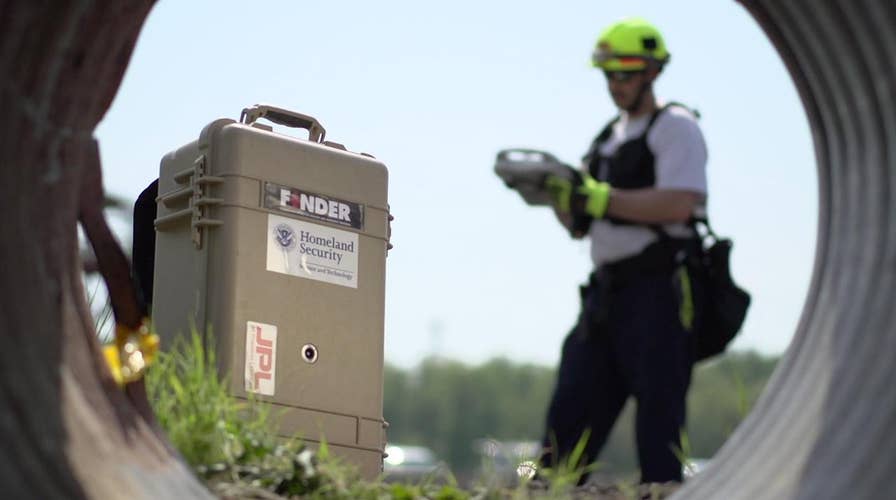NASA trying to save victims of natural disasters
Fox Firepower: Allison Barrie shares a closer look at F.I.N.D.E.R, a revolutionary technology, developed by NASA, that can help rescue someone, whether they are conscious or not, using the person's heartbeat
What if you are still alive, but buried beneath rubble and with limited time left?
Maybe you are at work when an earthquake like the one that just hit Mexico City strikes. Or perhaps you are at home sheltering in a basement when a powerful hurricane, such as Harvey or Irma, strikes your home.
You are trapped under a massive amount of rubble without any way of escaping – unless someone can find you. It is the worst nightmare of many and can become all too-real in an instant.
HURRICANE IRMA: THE SCIENCE OF THE DEADLY STORM
Currently, search and rescue teams use methods like dogs, video cameras and listening devices to try to find trapped victims who are still alive. But NASA has worked on a new technology that may supersede all of those methods.
FINDER (short for Finding Individuals for Disaster and Emergency Response) takes advances for space exploration and is using them to save lives here on Earth.
This revolutionary technology can help rescue someone, whether they are conscious or not, using the person's heartbeat.
NASA’s Jet Propulsion Laboratory partnered with the Department of Homeland Security Science and Technology Directorate. They combined their security and space expertise to tackle this tough search and rescue problem in natural disasters.
About the the size of a carry-on suitcase, weighing less than 20 pounds, FINDER is easily transportable. It is a radar technology designed to detect the heartbeats of trapped victims and reveal where they are located beneath the rubble.
In these scenarios, it is a race against time. Being able to locate a victim more rapidly also means that it is possible more victims can be rescued before they run out of air or die from injuries or dehydration.
HOW NASA IS TRACKING TROPICAL STORM HARVEY
How does it work?
It can be particularly tough to locate someone who is unconscious or unable to respond due to their injuries. But with FINDER, their heartbeat and respiration sends out a signal for help no matter what.
Through the rubble, FINDER sends a low-powered microwave signal. The signal is approximately one-thousandth of a typical cell phone output.
FINDER hunts for changes in the reflections of those signals coming back. Specifically, it looks for the tiny changes in motion characteristic of a heart beating or breathing. It evaluates whether those changes are indeed a human heartbeat or human respiration.
If FINDER has succeeded in finding a heartbeat, then it displays a message notifying rescuers that someone is there.
From space to saving lives at home
Natural disasters like earthquakes, hurricanes and tornadoes can cause wreckage that makes it tough for radar signals. In particular, shattered or twisted materials can make signals very complex.
But FINDER masters these tricky challenges by wielding advanced algorithms similar to those developed by JPL to measure the orbits of satellites at Jupiter and Saturn. They’re also similar to those created to measure changes in the Earth's surface from satellites orbiting our planet.
The tech can pinpoint the trapped person to within approximately five feet. Depending upon the type of rubble, it could pinpoint the person's exact location.
In testing, FINDER has been successful locating someone buried 30 feet deep beneath mixed concrete, rebar and gravel – and from a distance of 30 feet. FINDER has also identified and located heartbeats from behind 20 feet of solid concrete.
In open spaces, this revolutionary technology can detect a human heartbeat buried beneath 30 feet of crushed materials, hidden behind 20 feet of solid concrete, and from 100 feet away.
Nepal
FINDER’s first real world deployment was a successful one, having been used in Nepal for search and rescue after the devastating 2015 earthquake.
R4 (one of two commercial partners using the technology, along with SpecOps Group) brought two prototype FINDERs devices to Nepal and found heartbeats beneath two collapsed structures. The four victims had been trapped for days beneath the rubble, but were finally rescued and their lives saved thanks to FINDER.
More to come
While useful in natural disasters, NASA JPL and DHS Science and Technology aren’t stopping there.
FINDER has also been discussed being used to find people trapped in burning buildings. FINDER could potentially help firefighters locate them immediately upon arriving on site.
It could even be used to find people lost in the wilderness or to monitor the vital signs of patients with very contagious diseases in quarantine and from a safe distance without having to touch them.





















